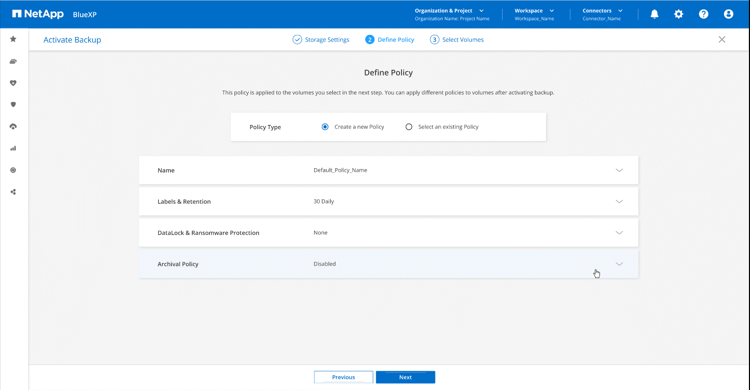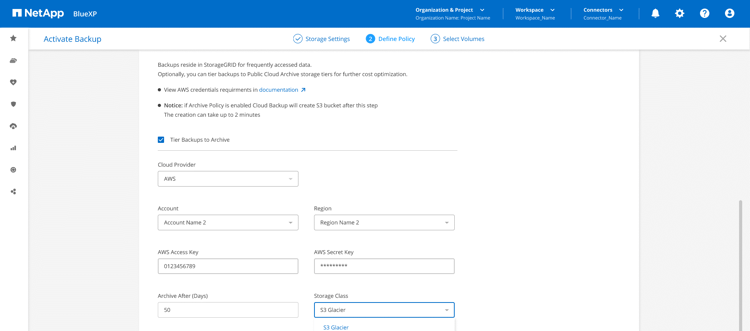Subscribe to our blog
Thanks for subscribing to the blog.
March 30, 2023
Topics: Cloud Backup Backup and ArchiveAdvanced7 minute read
With a steady increase in the size of data landscapes, organizations have a growing need for storing and managing their data. Additionally, most industries require long-term data retention to meet regulatory and compliance requirements.
Owing to its scalability, cost-effectiveness, accessibility, and efficiency, cloud storage has proved to be a popular solution for organizations with these specific requirements. Not only that, but cloud storage also aligns with information lifecycle management (ILM) best practices, especially for archival data storage.
In this blog, we’ll explore the Cloud Backup and BlueXP capabilities that enable moving on-prem NetApp StorageGRID® data to the cloud, and the benefits for organizations with long-term data retention needs.
Jump ahead to a topic in this piece:
- Understanding Information Lifecycle Management
- Long-term Data Retention From StorageGRID Using Cloud Backup
- Long-term Data Retention Use Cases
- Cloud Backup Benefits for Long-term Data Retention
- Conclusion
Understanding Information Lifecycle Management
Information lifecycle management (ILM) is a consistent way of managing information from the creation to the disposal phase. With a policy-based approach, ILM ensures a centralized strategy to manage an organization’s data through different phases. Having the right ILM guardrails in place is important to decrease associated data management and storage costs, while also adhering to organization-specific security and compliance standards.
Though ILM is often used interchangeably with Data Lifecycle Management (DLM), they aren’t quite the same thing. ILM is much more nuanced. DLM looks holistically at data sets and is focused on generic data attributes such as file size and age. By contrast, ILM zooms into the information handled by these files and offers a fine-tuned way of searching and managing it. This is especially important while dealing with regulated personal data such as with General Data Protection Regulation (GDPR).
ILM is made up of a few different phases that can be summarized as follows:
- Collect: The initial phase focuses on capturing data from various sources, such as from connected devices, social networks, user data, application data, etc.
- Store: The collected data is then goes to a storage media such as block storage or file storage, either on-premises, in the cloud, or in a hybrid solution
- Manage: Data is then aligned with the availability, security, and compliance guidelines specific to an organization
- Transform: If necessary, data is cleansed and converted to a usable format during the transform phase
- Use: Once data is in a usable format, it’s made available to applications and users to assist in different business processes
- Archive: Data that isn’t actively used but still needs to be retained for longer periods can be moved to cheaper yet still secured archival storage solutions
- Destroy: In the final phase, data that is no longer needed can be safely disposed
Organizations often find themselves in a dilemma with regards to the archive phase, especially when it comes to selecting the type of storage and the archive process to be followed. There are compliance and security standards to be met, and data needs to remain accessible in case it needs to be retrieved for auditing. While meeting these criteria, organizations also need to ensure that storage is secure and cost-effective since, over time, archival data can grow to terabytes or petabytes.
Long-term Data Retention From StorageGRID Using Cloud Backup
Cloud Backup, the SaaS-based multicloud and hybrid solution, part of NetApp BlueXP, supports your long-term data retention goals. The solution can take a backup of data from any ONTAP-based system and store it on StorageGRID on-prem, and then tier infrequently accessed data to archive storage in the public cloud.
Customers using ONTAP 9.12.1 and above, and StorageGRID version 11.3 and above, can benefit from this feature. Customers can tier data to AWS S3 Glacier or Deep Glacier storage as well as Azure Archive Storage, with support for Google Archive Storage in the roadmap. Enabling the archival process is simple and can be done from the BlueXP console login. Here’s how:
- Once you select the StorageGRID environment where the Cloud Volumes ONTAP backup is originally stored, you can create a new policy for a selected volume.

- Next, expand the option to configure Archival Policy.
- Select the option to “Tier backups to archival.”
- Select the target cloud environment and provide information to connect to the environment.
- Finally, define the number of days after which backup data should be archived.

Using this approach, organizations can meet their short-term backup retention needs by moving ONTAP data to StorageGRID and their long-term retention goals by moving backup data to cheaper archival storage in the cloud.
Long-term Data Retention Use Cases
Organizations belonging to heavily regulated fields such as insurance, legal, finance, and healthcare deal with large quantities of data. Often, that data is only used for a relatively short period of time and then very infrequently accessed. However, the data might be required in the future for reference or audit purposes. Let’s take a closer look at what this might look like in different industries:
- Healthcare industries need to keep patient data for multiple years for regulatory requirements
- Financial institutions are required to store data for a longer duration for audit and compliance purposes
- Government agencies need to store records and documents for multiple years or even decades for future reference
- Legal firms would need to store case files and documents for multiple years for reference or possible future processing even after a case is closed
Considering the access pattern in the above use cases, moving backup data to StorageGRID and later to an archival tier for long-term retention can prove to be beneficial.
Cloud Backup Benefits for Long-term Data Retention
Fitting into the archive phase of ILM, Cloud Backup provides organizations with a need for long-term data retention with a comprehensive solution that comes with a number of benefits.
Cost savings
Cloud Backup uses the archival tier of cloud storage, which offers the lowest cost possible using on-demand storage. While data storage costs of archival tiers are low, they often have a higher cost for data access. As data tiered from StorageGRID to cloud storage is used infrequently, access cost for data from the archival tier will also be minimal, keeping overall costs even lower.
Reliable on-prem backup
Cloud storage stores one backup copy on StorageGRID, which is tiered to the cloud based on defined policies. An organization will still have a reliable on-prem backup copy for immediate short-term retrieval. For example, on-prem StorageGRID can be used to restore backup data taken before the number of days as defined in the archival policy.
Optimal use of storage space
The cloud storage long-term retention feature in Cloud Backup helps customers with optimal usage of both on-prem StorageGRID and cloud storage, maximizing the return on both CAPEX hardware and OPEX cloud investments. The solution also preserves the ONTAP storage efficiency features, including data compression, deduplication, and compaction, which helps to further reduce storage space and cost.
Scalability
Due to its scalability, cloud storage can offer capacities of up to many petabytes. Therefore, organizations don't need extensive capacity planning exercises to handle their growing data estate storage needs. You can still continue to use the storage capacity of StorageGRID for short-term backups while depending on the scalability of cloud storage for long-term data retention.
Low maintenance
As cloud storage is a managed service, there’s no need to invest in or constantly upgrade storage hardware for archival data. The data remains available and can be recovered without the overhead of maintaining infrastructure. It also eases the operational overhead faced by organizations, especially when it comes to handling hardware devices such as storage boxes, tape drives, or backup tapes traditionally used for archival data storage.
Conclusion
Cloud Backup offers the simplest solution for archival and long-term retention of data from on-prem StorageGRID to cloud storage. By using the familiar configuration options from Cloud Backup, the onboarding and management process is also quite simple. As a first-party backup solution, the long-term retention capability from StorageGRID to the cloud is integrated out of the box and is available for all ONTAP customers.

